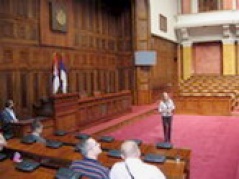National Assembly of the Republic of Serbia / Activities / Activity details

Friday, 8 September 2006
Journalists visit Assembly House
Journalists were today treated to a guided visit to Assembly House in Nikola Pasic Square, where they were shown the building and had the chance to learn about its history from curators from the National Assembly Protocol Service.
Journalists were today treated to a guided visit to Assembly House in
Assembly House was built near the spot where, on 30 November 1830, the Hatt-i Sharif, or ‘solemn decree’, of Ottoman Sultan Mahmud II was read out; the document guaranteed the Serbian people’s right to liberty, and affirmed Prince Milos’s right to hereditary rule over Serbia. Construction of a National Assembly edifice to plans of architect Konstantin Jovanovic was proposed as early as 1901; however, it was only in 1907 that building actually started, to designs of Jovan Ilkic, with the laying of the foundation stone by King Petar I Karadjordjevic. Construction lasted until 1936. Two sculptural groups, ‘The Dance of the Dark Horses’, cast in bronze in 1939 by Toma Rosandic, adorn the building’s main entrance.
From 1941 to 1944 the building housed the headquarters of the German army of occupation; after World War II, it was home to Yugoslavia’s highest government bodies: successively, to Parliaments of the Federal People’s Republic of Yugoslavia, the Socialist Federal Republic of Yugoslavia, the Federal Republic of Yugoslavia, and the State Union of Serbia and Montenegro. It is now home to




